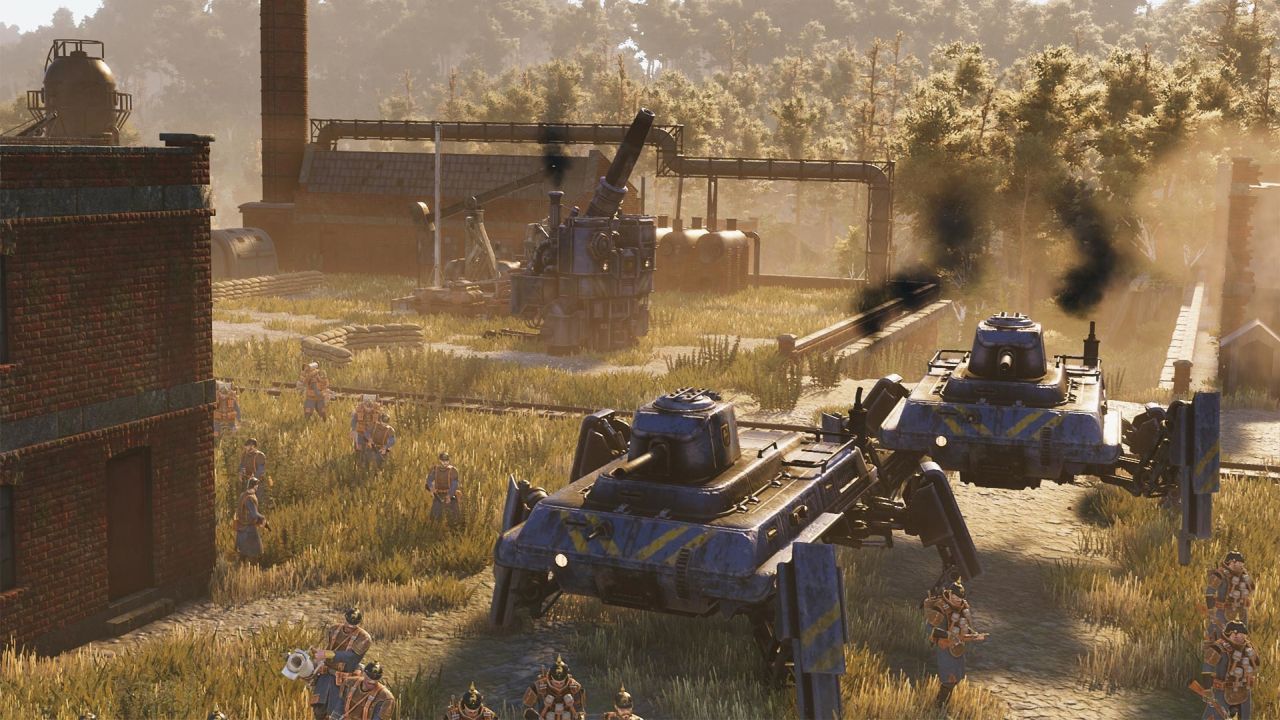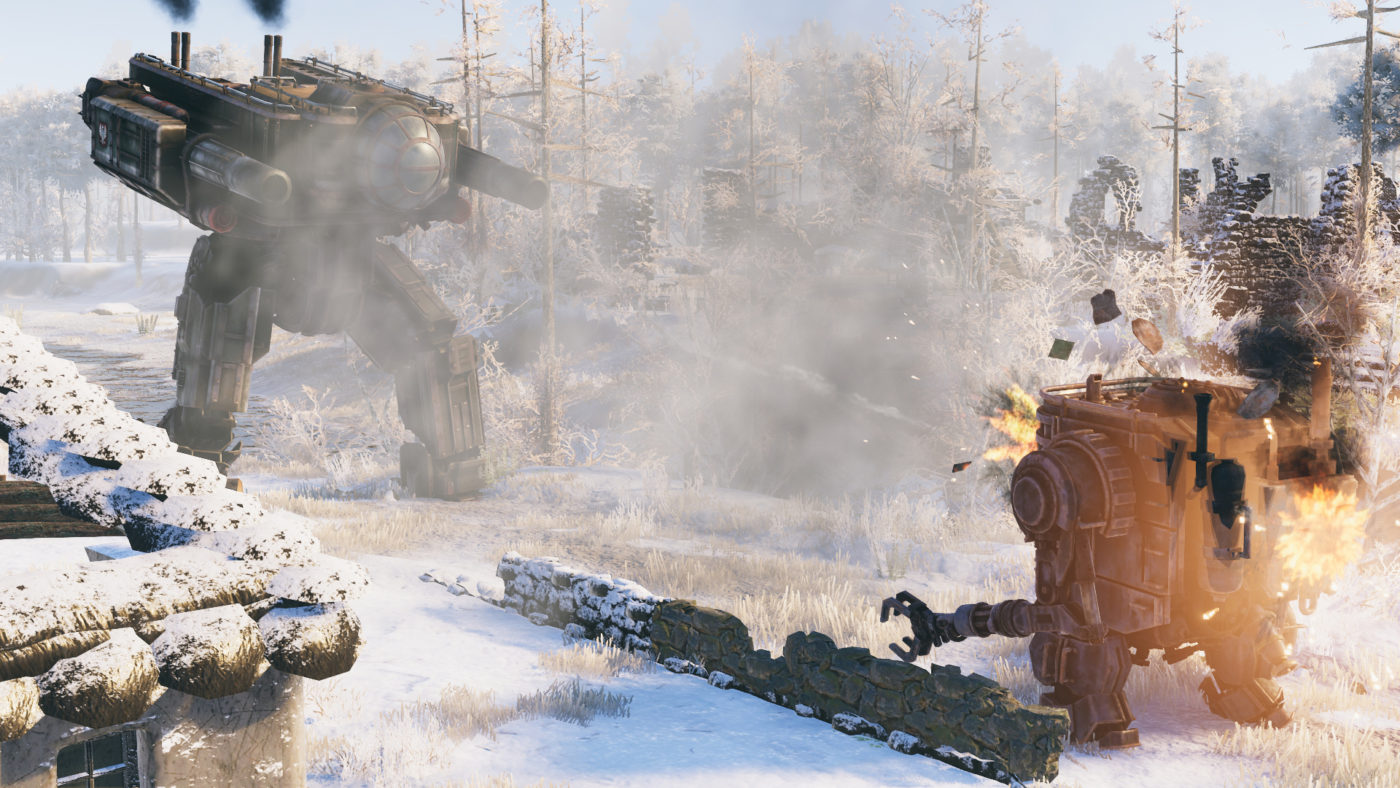

With each mission you receive a rating, and that adds to your scores. You have both a player and faction level that grows through usage. KING Art have put a lot of work into the rewards and progression system, one that I wish more games would adopt. They add a remarkable flavor to the game, whether it be campaign, skirmish, or multiplayer, and it works really well to see them in motion, almost as primitive mechwarriors. Units who take advantage of this will earn crit damage, and are able to bring them down a lot quicker than frontal assaults. All mechs from any faction are susceptible to attacks from behind, where they’re the weakest. Mechs not very fast, but they can easily defeat squads of human enemies just by itself. And for good reason, they’re powerful machines that can walk through buildings like they’re wading through a waist-high pool. From the website to trailers and other marketing, they’re everywhere.

Mechs are a central feature and focal point of the game. It’s a great system that will have you attached to your squads. Eventually they will be promoted into veteran and finally elite units, with additional tiers after.


For keeping your squads alive, they will accrue XP for capturing points, items, and killing enemies. With health pickups scattered around the map, this is very doable. All units gain experience, so it remains important to keep units alive for as long as possible. As enemy units die, there are weapon pickups to alter your existing classes to give them flamethrowers, cannons, and even just be able to throw grenades. The AI moves about the map too frequently to sit idly by, you must constantly keep improving, building and capturing. Each mission has a different population cap, so you won’t be able to turtle and build up units and resources until you’re ready. Each building has an advanced variant, but it isn’t always required as part of the campaign. They cover all aspects of what you’ll need, and then any defenses to keep them safe. You’ll build a headquarters, workshop, and barracks. There isn’t much in the way of base building. Aside from the story beats, you’ll be scouring the map to capture control points, as well as gather iron and fuel resources. This is the gameplay you should come to expect, and what era of gaming KING Art has targeted. There’s a little bit of StarCraft II in there, too, for flavor. The campaign is a slow, but enjoyable burn as it likes to focus on the characters over the conflicts.įrom a gameplay perspective, Relic’s Company of Heroes 1/2 and Dawn of War II come to mind immediately. Along the way you’ll play as nine heroes in total and their companions, who set out to be more outlandish than the last. The three factions each have their own goals and reasons for fighting. The factions have parallels to real-world countries, for instance Polania is Poland, Rusviet is Russia, and Saxony is Germany. With three different factions to play as, there’s surprisingly only a few minor differences between them, but do offer separate stories to tell. There are 21 missions in total, with seven missions per faction. It simultaneously offers character and world building, almost effortlessly. It’s a really cute and clever introduction to mechanics, real-time strategy games, and the game itself.
#IRON HARVEST REVIEW HOW TO#
Then starts learning how to shoot from her brother, and how to defend herself over the years. The first mission places you in the tiny shoes of Anna, a young girl who gets bullied by some kids during winter when throwing snowballs. It’s become a war-torn dieselpunk world, and everyone’s on edge. Legs have replaced wheels on everything like tanks and cars, because they all walk now. Mechs were used in this war, and have had technological impacts that have yet to be understood. Fictional countries are still recovering from the Great War. In this world, it’s an alternate reality 1920 after the first World War. Sharing a world and elements that World of 1920+ that Scythe the board game does, Iron Harvest exists in the same one, but they’re considered separate entities beyond that. As it stands, Iron Harvest is a revitalization of the RTS genre that’s sat dormant for too long, until now. The multiplayer is lacking in a few key areas, hurting the longevity of the game for the time being.
#IRON HARVEST REVIEW FULL#
It’s got a lengthy, strong campaign full of heart that offers three distinct viewpoints with focus on giant, hulking mechs that release wanton destruction. Iron Harvest aims to capture the mid-2000s era of RTS gaming, and mostly succeeds at that goal. Real-time strategy games like Company of Heroes and Dawn of War II are now considered classics, relics of the past.


 0 kommentar(er)
0 kommentar(er)
